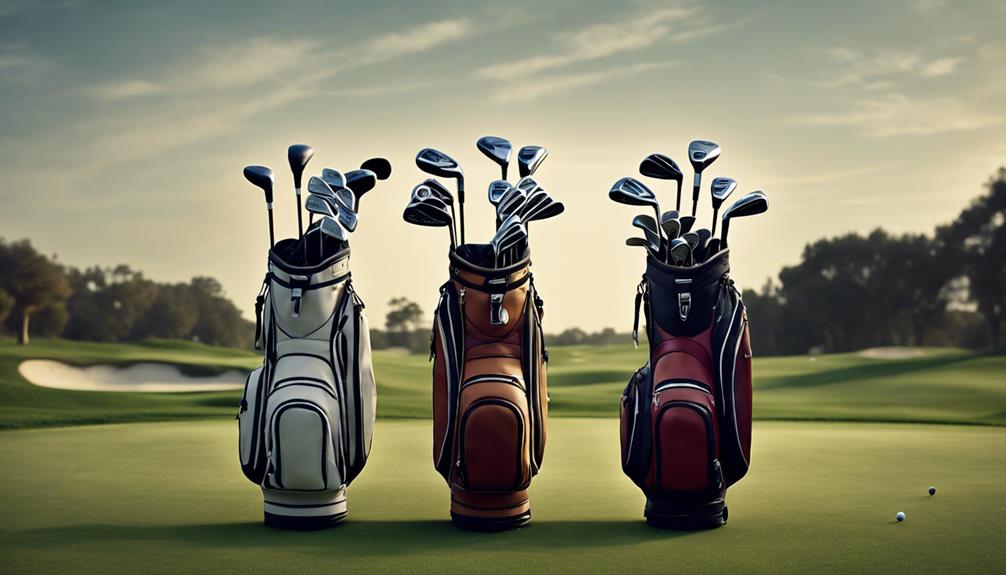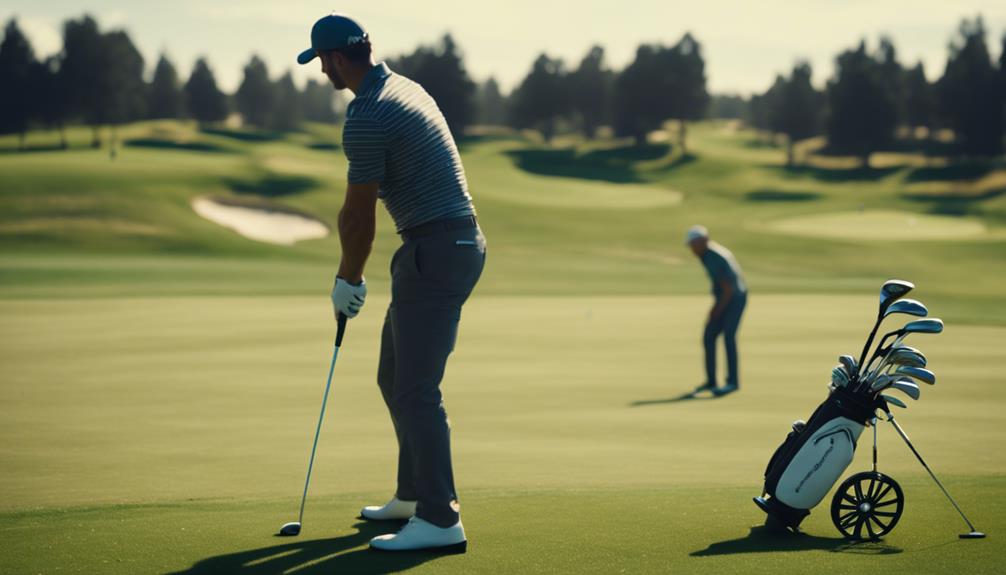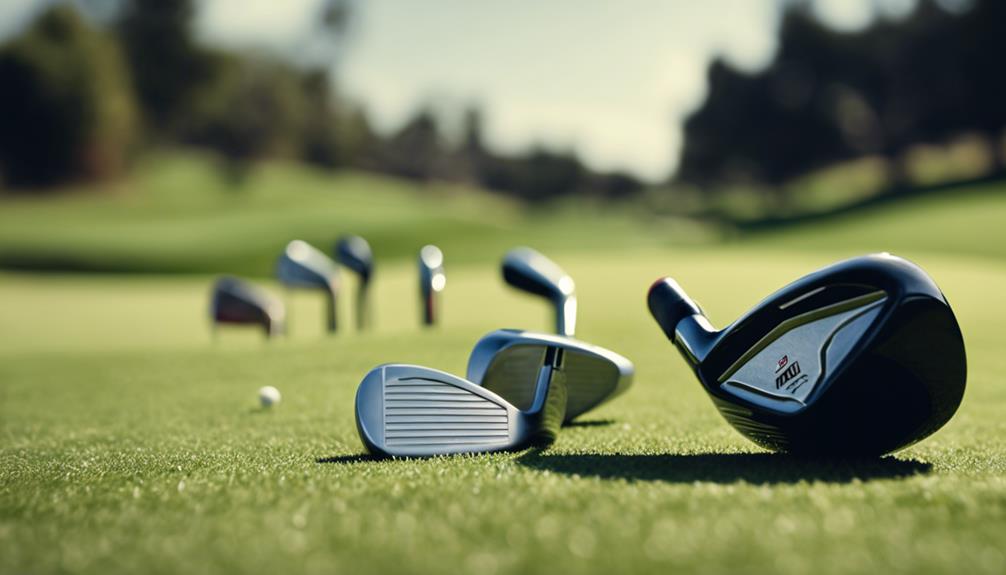- 7 Top Flite Golf Clubs XL for Improved Performance - September 28, 2024
- Top Flite Golf Clubs: Top 5 Reasons to Choose Them - September 28, 2024
- Top 3 Golf Club Fitters for a Perfect Swing - September 28, 2024
You'll need a solid foundation of seven essential golf clubs to get started, including a driver, 5 or 7 wood, 6 hybrid, 8 iron, pitching wedge, sand wedge, and putter, which will help you develop fundamental skills and build a strong game. Focus on developing your skills rather than relying on a single club for all shots. As you progress, you'll want to balance forgiveness, distance, and control in your club selection, and exploring customization options will become key to refining your set. With the right clubs in hand, you'll be set to take your game to the next level.
Key Takeaways
- As a beginner, focus on developing fundamental skills with seven essential clubs: driver, 5 or 7 wood, 6 hybrid, 8 iron, pitching wedge, sand wedge, and putter.
- Forgiveness is critical for beginners, so look for clubs with larger sweet spots and graphite shafts for improved accuracy and distance.
- A balanced set should include a mix of forgiveness, distance, and control, with consistent loft gaps between clubs for optimized performance.
- Consider your personal swing style, skill level, and distance needs when selecting clubs, and prioritize short game practice for improved overall performance.
Essential Golf Clubs for Beginners
When assembling your first golf set, prioritize the inclusion of seven essential clubs that will help you build a strong foundation and improve your game over time.
As a beginner, it's vital to focus on clubs that will help you develop fundamental skills, rather than trying to tackle every shot with a single club.
Your beginner golf set should include a driver, a 5 or 7 wood, a 6 hybrid, an 8 iron, a pitching wedge, a sand wedge, and a putter.
These essential golf clubs will provide you with the necessary tools to tackle various shots and situations on the course.
The 6 hybrid is a great substitute for long irons, offering more forgiveness and distance.
The 8 iron is perfect for shorter approach shots and chipping around the greens, while the sand wedge is a must-have for escaping bunkers and managing short shots.
Choosing the Right Clubs
To assemble a well-rounded golf set, you'll need to carefully select clubs that cater to your unique swing style, skill level, and personal preferences, ensuring a harmonious blend of forgiveness, distance, and control.
When choosing the right clubs, consider the following key factors:
- Forgiveness: Clubs are designed to provide more or less forgiveness, so it's vital to opt for ones that suit your skill level. Forgiving clubs, like cavity back irons and hybrids, offer larger sweet spots for improved accuracy and consistency.
- Shaft material: Graphite shafts are a popular choice for beginners due to their lighter weight, allowing for increased swing speed and distance while providing a smoother impact.
- Shaft flex: Understanding your swing speed is significant for selecting the appropriate shaft flex. Regular flex clubs are more forgiving for those with slower swing speeds.
Understanding Golf Club Basics

You'll need to grasp the fundamental components of a golf club set to make informed decisions about your equipment. As you build your golf bags, understanding the basics is essential. Here's a breakdown of the essential clubs you need:
| Club Type | Description |
|---|---|
| Driver | Used for tee shots, providing maximum distance |
| Irons | Utilized for shots within 200 yards of the green |
| Hybrid | Designed to be more forgiving and easier to hit, ideal for beginners |
| Wedges | Include pitching and sand wedges, used for high-angle shots |
Keep in mind that you're allowed to carry a total of 14 clubs in your bag, including one putter. Consistent loft gaps between clubs are important for effective club selection, ensuring each club serves a distinct purpose in your game. As you explore the world of golf, understanding these basics will help you make informed decisions about the clubs you need. By mastering the fundamentals, you'll be well on your way to selecting the right clubs for your game.
Beginner Golf Set Makeup
Building a solid beginner golf set requires a thoughtful selection of clubs that cater to your learning needs. A well-rounded set should include a mix of forgiving clubs and essential irons. As a beginner, you want to focus on building foundational skills and improving your overall game.
Here are the essential clubs you should include in your beginner golf set:
- Driver and Fairway Woods: These clubs provide distance and forgiveness, helping you hit the ball far and straight.
- 6 Hybrid: Instead of long irons (3-4-5), hybrid clubs are recommended for easier handling and better forgiveness.
- 8 Iron and Wedges: An 8 iron is vital for shorter approach shots and chipping around the green, while a sand wedge (54-57 degrees) helps you escape bunkers and manage strokes around the greens.
Advanced Golfer's Needs

As an advanced golfer, you're likely focused on fine-tuning your skills and refining your club selection.
To take your game to the next level, you'll want to prioritize practicing your short game, as it's essential for saving strokes and making up for any wayward shots.
Additionally, having a full set of irons and utilizing a launch monitor can help you optimize your club performance and make data-driven decisions.
Practice Short Game
To take your short game to the next level, focus on refining your skills within 100 yards of the hole, where a significant portion of strokes are taken during a round. As an advanced golfer, you know that mastering the short game is essential to shaving strokes off your score.
Here are some key areas to focus on:
- Wedge play: Develop a strong pitching wedge and sand wedge game to tackle various lie conditions. Practice controlling distance, trajectory, and spin to become more consistent around the green.
- Chipping and putting: Spend time honing your chipping technique, experimenting with different grips, stances, and swing lengths to find what works best for you. Also, dedicate practice time to improving your putting, focusing on pace, direction, and green reading.
- Hybrid integration: Consider incorporating hybrids into your short game, as they can provide additional forgiveness and make it easier to execute shots from tricky lies compared to long irons.
Full Set of Irons
With a refined short game in place, you'll want to turn your attention to crafting a well-rounded iron set that efficiently covers the various distances and shot types you'll encounter on the course.
As an advanced golfer, you'll need a full set of irons, typically consisting of clubs from 4-iron to 9-iron, to effectively cover the range of distances and shot types. Having a complete iron set allows you to identify gaps in your club distances and make more precise shots as you build your skills.
You may benefit from using cavity back irons, which offer a larger sweet spot and increased forgiveness on off-center hits. However, the choice of iron set composition depends on your swing speed and personal preferences, which can be determined through professional fitting sessions.
It's essential to understand the lofts and gaps between each club in your iron set to optimize your performance and achieve consistent results. By fine-tuning your iron set, you'll be able to tackle the course with confidence and precision.
Launch Monitor Benefits
By harnessing the power of launch monitor technology, you can access precise insights into your swing dynamics, empowering you to fine-tune your equipment and technique for peak performance.
To improve your skills, a launch monitor provides critical data on:
- Club head speed and ball speed: Optimize your shaft flex and club customization for your swing speed.
- Launch angle and spin rate: Identify the ideal club loft and configuration for your game.
- Yardage gaps between clubs: Guarantee consistent loft gaps for better club selection on the course.
Important Considerations
When assembling your golf bag, you'll need to contemplate a multitude of factors that greatly impact your performance on the course. One vital consideration is the balance of distance and versatility, ensuring you have the right clubs to tackle various shots. With only 14 clubs allowed, it's important to prioritize consistent loft gaps between clubs for effective selection and performance.
| Club Selection Factors | Why They Matter |
|---|---|
| Swing foundation and practice habits | Influences club type and specifications required |
| Forgiving clubs (hybrids, cavity back irons) | Ideal for beginners, building foundational skills and consistency |
| Professional fitting services | Determines best shaft flex and club specs for individual swing characteristics |
As a golfer, your swing foundation and practice habits greatly influence the type of clubs you require. If you're a beginner, focus on forgiving clubs to help build your skills. Additionally, consider professional fitting services, including launch monitors, to determine the appropriate shaft flex and club specifications tailored to your unique swing characteristics. By carefully considering these factors, you'll be well on your way to assembling a golf bag that sets you up for success on the course.
Getting the Right Fit

As you start getting fitted for your ideal golf clubs, it's crucial to focus on two critical aspects: club fitting essentials and shaft flex matters.
You'll want to make sure that your clubs are tailored to your unique swing characteristics, and that starts with understanding the importance of proper club fitting.
Club Fitting Essentials
How do you guarantee your clubs are tailored to your unique swing style, a vital factor in enhancing your game? Club fitting essentials are important in finding the perfect clubs that complement your skills and elevate your performance.
Here are some key considerations for club fitting essentials:
- Understand your swing characteristics: A launch monitor can help determine the proper shaft flex and club head speed based on your unique swing characteristics.
- Get a professional fitting appointment: A certified club fitter guarantees consistent loft gaps between hybrids and irons, which is vital for peak performance.
- Experiment with different brands and styles: Find the best fit for your individual playing style and comfort by trying out different clubs.
Shaft Flex Matters
By understanding your swing characteristics, you're now ready to focus on finding the perfect shaft flex that complements your unique motion, a vital component in maximizing distance and accuracy.
The correct shaft flex is essential, as it affects how the club responds during the swing. As a golfer, you'll want to take into account your swing speed and club head speed to determine the ideal shaft flex for your game.
Regular flex shafts are often suitable for beginners, as they're more forgiving and easier to swing, while stiff flex shafts may be necessary for higher swing speed players seeking better control.
Graphite shafts, in particular, can provide additional benefits, such as increased distance and reduced vibrations.
To guarantee you're getting the right fit, think about utilizing a launch monitor or booking a professional fitting appointment. A properly fitted shaft flex will contribute to improved performance, consistency, and overall enjoyment of the game.
Club Selection for Beginners
When building your golf club set, you'll want to prioritize the essentials, focusing on a mix of clubs that cater to your distance and performance needs.
As a beginner, it's vital to start with a smaller set of clubs to simplify decision-making and focus on skill development. A good starting point is a set of 6-9 clubs, including:
- Driver: for long-range shots
- Fairway wood or hybrid: for mid-range shots
- Irons: for shots from the fairway or rough
Forgiving clubs, such as cavity back irons or hybrids, are important for beginners to help build foundational skills and improve accuracy and consistency.
Using a 6 hybrid instead of long irons (3-4-5) is recommended, as hybrids provide a higher launch and are easier to hit.
Ideal Club Set-up for Beginners

As you're building your ideal club set-up, you'll want to focus on the essential clubs that'll help you cover various distances and situations on the course.
You'll need to choose the right driver and woods to get you out of the tee box, and select hybrids and irons that'll help you navigate the fairway and rough.
Essential Clubs for Beginners
You'll want to start with a well-rounded set of clubs that includes a driver, a fairway wood or hybrid, a few irons, and a putter, as these will form the foundation of your beginner's golf set. As a beginner, it's important to prioritize forgiveness and ease of use when selecting your clubs.
Here are the important clubs you should focus on:
- Hybrids: Instead of long irons (3-4-5), consider hybrids for their forgiving nature and ease of use.
- 8 Iron: This club is significant for shorter shots to the green and for chipping, making it a critical part of your set.
- Sand Wedge: A sand wedge is crucial for playing out of bunkers and managing short-game situations around the greens.
Driver and Wood Selection
Building a solid foundation in your golf game starts with selecting the right driver and wood, which will help you master tee shots and long fairway shots with ease.
As a beginner, you'll want to focus on one driver and either a 5 or 7 wood, as these clubs provide the necessary distance and forgiveness for tee shots and long fairway shots. Your driver is primarily used for long-range shots, aiming to get the ball onto the fairway from the tee, while your 5 or 7 wood can serve as an alternative to longer irons due to its higher loft.
When selecting a driver, make sure to choose one with the proper loft and shaft flex to maximize distance and accuracy, making it easier to develop your swing. A 5 or 7 wood is recommended over a #3 fairway wood, as its higher loft helps you achieve better launch angles and more forgiving shots.
Additionally, consider adding hybrids to your set, which combine features of both woods and irons, making them easier to strike off the fairway and replacing long irons effectively.
Hybrid and Iron Choices
Selecting the right hybrids and irons is essential to completing your ideal club set-up as a beginner, as these clubs will help you navigate the fairway and approach the green with confidence.
When it comes to hybrids, you'll want to opt for a 6 hybrid instead of long irons (3-4-5) for easier playability and higher launch angles. This will make it easier for you to hit the ball consistently and with more accuracy.
Here are some key considerations for your iron selection:
- Forgiving designs: Focus on cavity back irons and hybrids, which feature larger sweet spots for improved accuracy.
- Easy to hit: Look for irons with a larger clubhead and a more upright face to help you strike the ball more consistently.
- Versatility: Choose irons that can be used for a variety of shots, such as the 8 iron, which is useful for shorter shots to the green and chipping.
Mastering Club Usage
As you step onto the course, mastering club usage is critical to shaving strokes off your score, and it all begins with a deep understanding of the specific distances each club can achieve.
You've got seven clubs in your bag, but which one is the right club for the job? Practicing on the driving range helps you develop muscle memory and confidence in choosing the right club for various situations.
Familiarize yourself with the characteristics of each club, such as the loft and design of hybrids compared to irons. This knowledge enhances your decision-making when faced with different obstacles on the course.
Experimenting with a variety of clubs helps you learn their unique performance, allowing for more strategic play and improved scores over time.
Using a launch monitor can provide valuable feedback on swing speed and club performance, helping you better understand which clubs suit your swing style and ability.
Frequently Asked Questions
How Do I Know What Golf Clubs I Need?
To determine the right clubs for you, you'll need to undergo a skill assessment and club fitting, considering factors like swing speed and style, to find the perfect set that complements your unique game.
How Many Clubs Do I Need to Play Golf?
As you step onto the lush green course, you're wondering how many clubs you need to play golf. To start, you'll need a handful of essential equipment, including a driver, irons, wedges, and a putter – around 6-9 clubs to cover the basics.
How Do I Choose a Set of Golf Clubs for Beginners?
When selecting a set of golf clubs as a beginner, you'll want to focus on club fitting, considering factors like your swing speed and style, and seek out beginner tips, such as opting for hybrids and forgiving club designs.
Is a 5-Hybrid Easier to Hit Than a 5-Iron?
When comparing the two, you'll find the 5-hybrid's advantages lie in its easier launch, higher trajectory, and forgiveness on mis-hits, making it a better choice for beginners, whereas the 5-iron's challenges include a steeper learning curve and less room for error.
Conclusion
Carefully curate your club collection to conquer the course with confidence.
Craft a cohesive set that caters to your unique swing style, catering to consistency and control.
Concentrate on essential clubs that complement your game, and don't be afraid to customize for peak performance.
By deliberately selecting the right tools, you'll be driving, chipping, and putting your way to golf greatness in no time.




